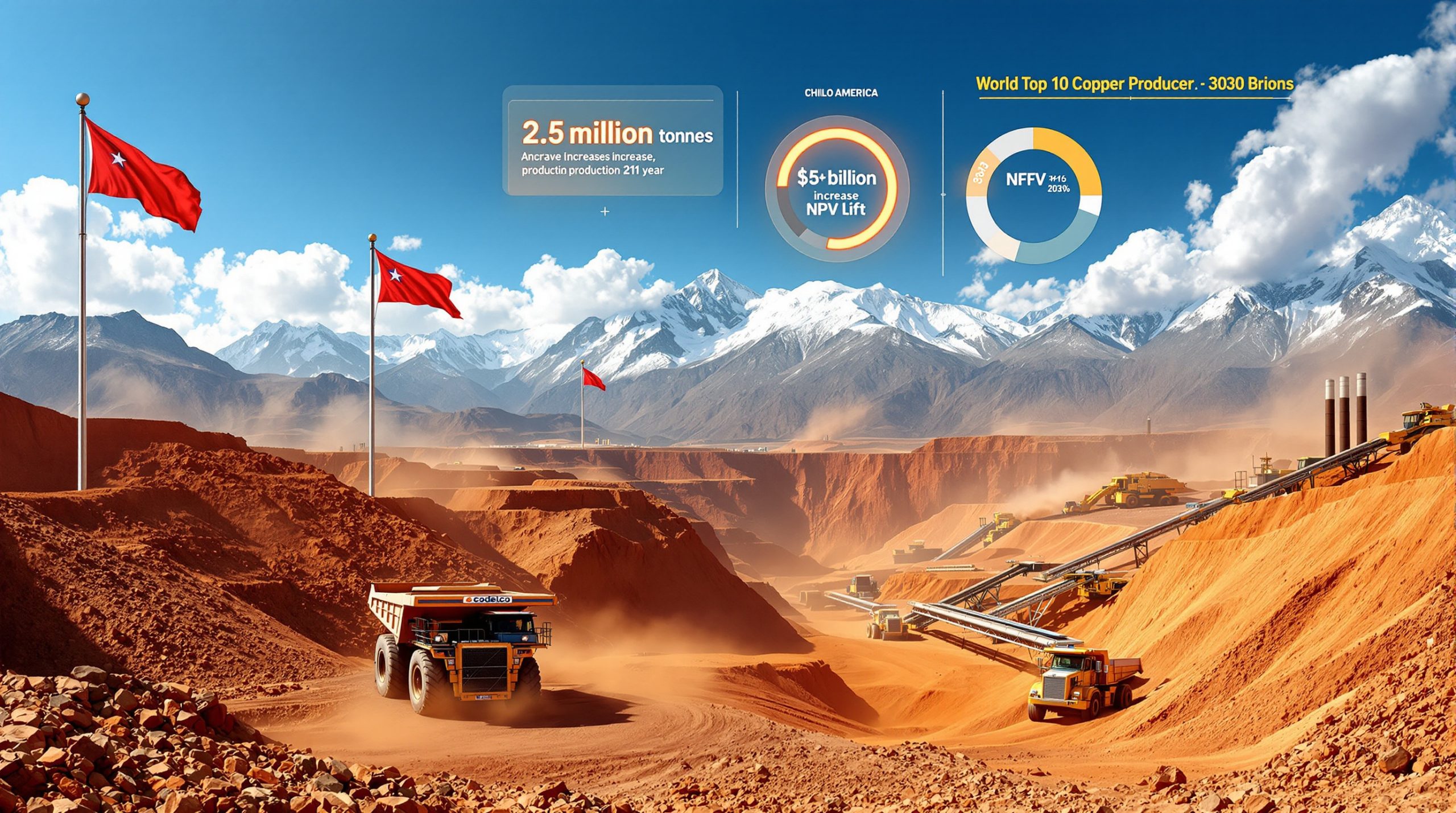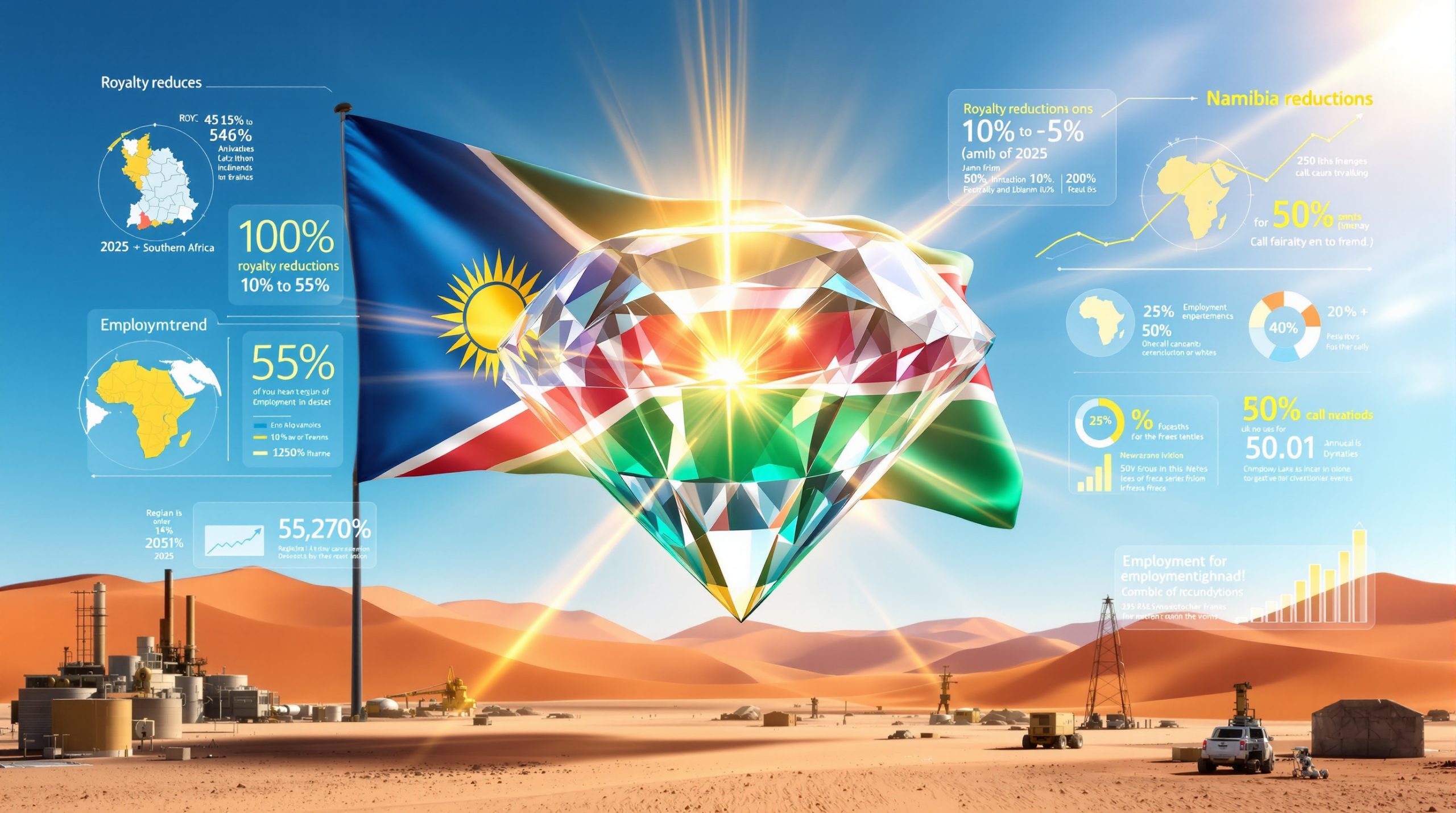Vedanta's Copper Financing Strategy: RMB Partnership and Expansion Plans
Vedanta Resources Ltd.'s Zambian copper unit has taken a significant step toward revitalizing its operations through a strategic partnership with South Africa's Rand Merchant Bank (RMB). This collaboration aims to secure up to $1 billion in debt financing to fund the expansion of Konkola Copper Mines (KCM) operations in Zambia, positioning the company for substantial growth in copper production.
The financing initiative, while still in early-stage discussions with potential lenders, represents a critical component of Vedanta's commitment to transforming KCM into a major player in Africa's copper industry. RMB's expertise in structuring complex mining finance deals in Africa makes them an ideal partner for this ambitious undertaking.
"We're evaluating various financing alternatives, including internal accruals, debt instruments, and equity options to support our long-term vision for KCM," a Vedanta spokesperson confirmed via email. This financing strategy comes amid copper prices hovering around $4.55 per pound, reflecting market volatility that hasn't deterred Vedanta's expansion plans.
How Did Vedanta Regain Control of KCM?
The current financing initiatives follow Vedanta's successful resolution of a protracted dispute with the Zambian government approximately 10 months ago. The Indian mining giant, led by billionaire Anil Agarwal, regained 80% control of KCM after years of legal battles that began when Zambia placed the operation under administration in 2019.
The settlement, finalized in July 2024, ended a five-year standoff that had significantly hampered KCM's operations and development. The agreement restored investor confidence in Zambia's mining sector, which had been shaken by the government's previous actions against foreign mining companies.
Investment Commitments That Secured the Deal
Vedanta's return to KCM came with substantial financial commitments that proved crucial to securing the settlement. The company pledged a total investment of $1 billion over five years to revitalize the operation.
Since regaining control, Vedanta has already invested $330 million in KCM, primarily focused on:
- Clearing outstanding debts to creditors and suppliers
- Stabilizing existing operations that deteriorated under administration
- Initiating critical maintenance programs at processing facilities
- Preliminary work on the Konkola Deep mining project
The Zambian government maintained a 20% ownership stake in KCM through its investment holding company, ZCCM-IH, preserving national interests while allowing Vedanta to implement its turnaround strategy.
What Are Vedanta's Production Goals for KCM?
Vedanta has established ambitious production targets that aim to transform KCM from a struggling operation into one of Africa's premier copper producers. The scale of this transformation cannot be overstated—the company is targeting a 650% increase from current production levels.
Production Metrics and Timelines
Under the court-appointed administrator, KCM's output had dwindled to approximately 40,000 tons of copper in 2023, far below the mine's potential. Vedanta's vision includes:
- Reaching an annual production capacity of 300,000 tons of copper
- Implementing a phased ramp-up over the next five years
- Focusing on efficiency improvements at existing operations in the short term
- Delivering the transformative Konkola Deep project as the cornerstone of growth
"Konkola Deep will become Africa's deepest copper mine and a flagship project for both Vedanta and Zambia," noted Ajay Goel, Vedanta's Chief Financial Officer, in a recent Bloomberg interview.
Technical Challenges of the Konkola Deep Project
The Konkola Deep mining project presents significant technical challenges that Vedanta must overcome:
- Accessing high-grade ore bodies at depths exceeding 1,500 meters
- Managing substantial water inflow (estimated at 350,000 cubic meters daily)
- Implementing specialized deep-mining equipment and techniques
- Developing enhanced ventilation systems for deep-level mining
- Addressing geotechnical risks inherent to deep underground operations
Industry experts note that deep-level mining projects typically require 3-5 years to reach full production capacity, highlighting the long-term nature of Vedanta's investment timeline.
Why Is Copper Investment Continuing Despite Market Challenges?
Despite recent copper price volatility and geopolitical uncertainties, including concerns about potential Trump tariff impact on copper stocks, major mining companies continue to invest heavily in copper projects. This sustained commitment reflects the industry's confidence in copper's fundamental long-term outlook.
Driving Factors Behind Continued Investment
The global push toward renewable energy and electrification has created what industry analysts call a "structural deficit" in copper markets. According to the International Energy Agency, each megawatt of renewable energy requires approximately three tons of copper—five times more than conventional power generation.
Key factors supporting ongoing investment include:
- Projected supply gaps: Industry forecasts from CRU Group indicate a potential 10 million ton copper deficit by 2030
- Electric vehicle growth: Each EV requires 2-4 times more copper than internal combustion vehicles
- Renewable energy expansion: Solar and wind installations continue to drive demand growth
- Infrastructure modernization: Grid upgrades and energy storage solutions are copper-intensive
"The copper market is facing a perfect storm of rising demand from energy transition technologies while struggling with limited new supply coming online," noted a recent CRU Group analysis report.
Competitive Landscape in Zambian Copper
Vedanta isn't alone in its bullish outlook on Zambian copper. The country has attracted investments from several major mining houses:
| Company | Investment | Project Focus |
|---|---|---|
| Barrick Gold | $2 billion | Lumwana Super Pit expansion |
| First Quantum Minerals | $1.5 billion | Kansanshi smelter and mine expansion |
| China Non-Ferrous Metals | $800 million | New smelter facility |
| Vedanta Resources | $1 billion | KCM revival and Konkola Deep |
This competitive investment landscape underscores industry-wide confidence in Zambia's copper potential despite market uncertainties.
What Financing Options Is Vedanta Exploring?
Vedanta is pursuing a diversified financing strategy to fund its ambitious $1 billion investment plan for KCM. While the partnership with Rand Merchant Bank represents the current focus, the company is evaluating multiple capital raising methods to secure the necessary capital.
Multiple Financing Pathways
The company's multilayered approach includes:
- Debt instruments: Working with RMB to structure appropriate debt packages
- Internal accruals: Leveraging cash flow from existing global operations
- Equity considerations: Potentially raising capital through equity markets
- IPO prospects: Evaluating a public listing for KCM as a standalone entity
- Prepayment arrangements: Discussing offtake agreements with commodity traders
"An IPO could unlock significant value for all stakeholders, including our Zambian partners," Ajay Goel mentioned in his Bloomberg interview, though emphasizing that such plans remain in early evaluation stages.
Understanding Prepayment Financing in Mining
One financing option gaining popularity in the mining sector is prepayment arrangements with commodity traders. These structured deals work by:
- A trading house provides upfront capital for mine development
- In return, they secure future copper production at predetermined terms
- The mining company gains immediate financing without traditional debt
- The trader secures long-term supply in an increasingly competitive market
Such arrangements have become increasingly common in copper mining, with companies like Trafigura and Glencore actively participating in similar deals throughout Africa.
Vedanta aims to achieve approximately a 60:40 debt-to-equity ratio for KCM's financing, according to their latest investor presentations, balancing leverage with financial stability.
How Does This Investment Fit into Zambia's Copper Industry?
Zambia ranks as Africa's second-largest copper producer after the Democratic Republic of Congo, with annual production of approximately 800,000 tons as of 2024. The mining sector contributes roughly 12% to the country's GDP and remains its economic cornerstone.
Zambia's Position in Global Copper Production
The Zambian copper belt contains some of Africa's richest copper deposits, with ore grades typically ranging from 2.3% to 4.5%—significantly higher than the global average of 0.6%. This geological advantage makes Zambian copper attractive despite the country's landlocked location and infrastructure challenges.
KCM's potential 300,000-ton annual production would represent nearly 40% of Zambia's current national output, making Vedanta's investment critically important to the country's economic ambitions and the global copper supply forecast.
Infrastructure Challenges and Opportunities
Despite its mineral wealth, Zambia faces significant infrastructure constraints that impact mining economics:
- Power supply constraints: Recurring load-shedding affects operational reliability
- Transportation bottlenecks: Limited rail capacity increases export costs
- Water management issues: Aging water infrastructure requires modernization
- Skills development needs: Technical expertise shortages in specialized mining roles
According to the African Development Bank's 2023 infrastructure report, Zambia's railway network can currently handle only about 60% of potential mineral exports, forcing companies to rely on costlier road transportation for the remainder.
The Zambian government has recognized these challenges, with the Finance Minister stating in April 2025: "Our mining reforms aim to double national production by 2030 through strategic infrastructure investments and regulatory improvements."
What Challenges Might Impact Vedanta's KCM Expansion?
Despite the promising outlook, Vedanta's ambitious plans for KCM face several significant challenges that could impact the timeline and success of the expansion efforts.
Market and Economic Risk Factors
Copper prices have demonstrated considerable volatility, with annualized price swings of approximately 20% based on London Metal Exchange data from 2024. This volatility creates uncertainty for long-term investment planning and project economics, affecting copper price prediction reliability.
Other economic concerns include:
- Potential impact of President Trump's trade policies on global metal markets
- Rising interest rates affecting the cost of capital for mining projects
- Competition for skilled labor driving up operational costs
- Increasing costs for critical mining equipment and supplies
Operational and Jurisdictional Challenges
KCM's operations face specific risks that must be carefully managed:
- Water management: The Konkola mine requires pumping approximately 350,000 cubic meters of water daily
- Power reliability: Zambia's electricity grid faces generation shortfalls and distribution issues
- Regulatory considerations: Mining royalty rates currently stand at 15% under Zambia's 2024 tax code
- Labor relations: The 2024 mining sector strikes cost the industry an estimated $50 million in lost output
"Zambia's 2025 election could potentially revive resource nationalism concerns that have historically affected foreign mining companies," noted a recent Economist Intelligence Unit analysis.
The case of First Quantum Minerals' $500 million tax settlement in 2024 serves as a cautionary example of the potential regulatory complexities of operating in Zambia, despite recent improvements in the investment climate.
FAQ: Vedanta's Copper Operations in Zambia
What is Konkola Copper Mines (KCM)?
KCM is Zambia's largest integrated copper producer, with operations spanning the entire value chain from mining to refined metal production. The company's assets include:
- The Konkola underground mine in Chililabombwe
- The Nchanga underground and open-pit mines in Chingola
- Concentrator plants at both Konkola and Nchanga
- The Nchanga smelter with 311,000-ton annual capacity
- The Nkana refinery producing copper cathodes
- A tailings leach plant recovering copper from historical waste
- A sulfuric acid plant producing 1,850 tons daily as a byproduct
The operation also produces cobalt, gold, and silver as byproducts of copper processing.
Who owns KCM currently?
Vedanta Resources owns 80% of KCM following the 2024 settlement, while the Zambian government maintains a 20% stake through its mining investment holding company, ZCCM-IH (Zambia Consolidated Copper Mines Investment Holdings).
How much is Vedanta investing in KCM?
Vedanta has committed to investing approximately $1 billion over five years, with $330 million already invested since regaining control in July 2024. This investment covers operational improvements, debt repayment, and the development of the Konkola Deep project.
What is the significance of the Konkola Deep project?
The Konkola Deep mining project represents one of Africa's most significant copper development projects, targeting rich ore bodies at depths exceeding 1,500 meters. When completed, it will be:
- Africa's deepest copper mine
- Access to ore grades averaging 3.45% copper (5x global average)
- A 30+ year mine life extension for KCM operations
- A critical driver for reaching the 300,000-ton production target
How does this investment compare to other copper projects in Africa?
This investment aligns with other major copper developments in the region, including:
- First Quantum's $1.5 billion Kansanshi expansion in Zambia
- Barrick Gold's $2 billion Lumwana Super Pit project
- Ivanhoe Mines' Kamoa-Kakula project in the DRC ($1.3 billion)
- China Non-Ferrous Metals' $800 million smelter development
Collectively, these investments reflect the industry's confidence in the African Copperbelt's long-term potential despite near-term market volatility.
Future Outlook for Vedanta's Copper Operations
Strategic Importance to Vedanta's Portfolio
The KCM operation represents a cornerstone of Vedanta's global copper strategy and a significant component of the company's overall metals portfolio. With successful implementation of effective copper investment strategies, KCM could provide:
- Approximately 30% of Vedanta's global copper production
- A geographically diversified revenue stream
- Access to high-grade ore bodies with lower production costs
- Strategic positioning in Africa's resource landscape
- Enhanced sustainability credentials through modernized operations
Long-term Vision and Milestones
Vedanta's roadmap for KCM includes several key milestones beyond the immediate five-year investment horizon:
- 2025-2026: Complete critical maintenance and operational stabilization
- 2026-2027: Ramp-up initial Konkola Deep production areas
- 2027-2028: Begin dewatering deeper mining levels
- 2028-2029: Achieve sustained production growth toward the 300,000-ton target
- Beyond 2030: Evaluate potential expansions beyond current plans
The successful revival of KCM would not only strengthen Vedanta's position in global copper markets but also deliver significant economic benefits to Zambia, including employment opportunities, tax revenues, and development of local supply chains.
With copper's essential role in the global energy transition firmly established, Vedanta's billion-dollar bet on Zambian copper appears strategically sound despite near-term challenges and uncertainties.
Note: This article provides information based on current data and projections. Investors should conduct their own research and consider market conditions before making investment decisions.
Want to Capitalise on the Next Major Copper Discovery?
Don't miss potential mining opportunities like Vedanta's copper expansion. Discovery Alert's proprietary Discovery IQ model provides instant notifications on significant ASX mineral discoveries, turning complex data into actionable investment insights. Explore historic examples of exceptional market returns by visiting our dedicated discoveries page and begin your 30-day free trial today.




